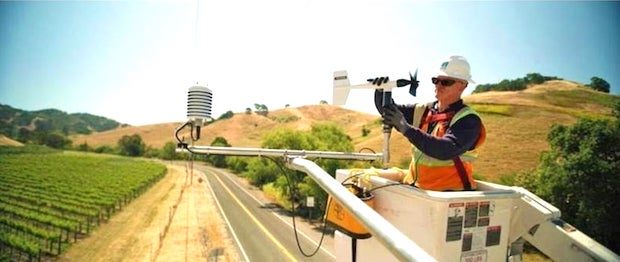PG&E deploying weather stations, HD camera network vs. wildfire risks

PG&E worker installing weather detector for wildfire prevention. WEBSITE
SAN FRANCISCO —Pacific Gas and Electric Company (PG&E) is expanding its network of weather stations and high-definition cameras to improve the company’s ability to predict and respond to extreme wildfire danger, the utility company announced.
By the end of 2019, PG&E plans to have at least 600 weather stations and 100 high-definition cameras in high fire-threat areas. These new installations are among many additional precautionary measures the company is implementing to reduce wildfire risks, following the 2017 and 2018 firestorms.
New weather stations in more than 35 counties
Building on the 200 weather stations it installed in 2018, PG&E has added an additional 200 in 2019 to capture localized, real-time data related to temperature, wind speeds and humidity levels.
Approximately 400 new weather stations are scheduled to be installed in 2019, prioritized in areas at elevated and extreme risk for wildfires, based on the California Public Utilities Commission (CPUC) High Fire-Threat District Map.
To help protect customers and communities during extreme weather events, electric power may be shut off for public safety in an effort to prevent a wildfire. This is called a Public Safety Power Shutoff (PSPS). PG&E’s meteorologists will feed data from these new stations to the company’s Wildfire Safety Operations Center team, where it can be utilized to help inform actions such as PSPS.
“These new weather stations help us monitor conditions around the clock, improving our ability to understand when and where it is necessary to take this precautionary action in the interest of public safety,” said Aaron Johnson, PG&E vice president of Electric Operations.
Counties that have already received weather stations include Alameda, Amador, Butte, Calaveras, Colusa, Contra Costa, El Dorado, Fresno, Glenn, Humboldt, Kern, Lake, Lassen, Madera, Marin, Mariposa, Mendocino, Monterey, Napa, Nevada, Placer, Plumas, San Benito, San Luis Obispo, San Mateo, Santa Barbara, Santa Clara, Santa Cruz, Shasta, Sierra, Solano, Sonoma, Tehama, Trinity, Tulare, Tuolumne and Yuba.
HD cameras throughout high fire-threat areas
PG&E has installed 25 of the 100 high-definition cameras planned for this year. The company has now installed 34 HD cameras since 2018, with a goal of installing 600 new cameras by 2022 as part of the ALERTWildfire Camera Network.
The ALERTWildfire Camera Network is a situational awareness tool built by the University of California, San Diego, the University of Nevada, Reno and the University of Oregon. The high-definition, pan-tilt-zoom cameras allow firefighters, first responders and companies like PG&E to confirm and monitor potential wildfires.
The system is used by fire managers and has been instrumental in tracking more than 500 fires since it was first developed in 2013. Images from the ALERTWildfire system are viewable online at www.alertwildfire.org.
Counties that have received cameras so far include Amador, El Dorado, Humboldt, Lake, Marin, Mariposa, Monterey, Napa, San Benito, Shasta, Sonoma, Tehama, Trinity, Yolo and Yuba.
More information can be found at pge.com/wildfiresafety.
Click here for more weather related news."

